Posted by Anita on 11.06.07 4:18 PM
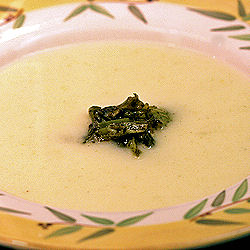 I don’t know about you, but it seems lately like my life is exploding with insanity. It’s not just work, either; it’s home and dogs and life in general. It’s all rush-rush, crazy nonstop chaos… and it’s not even the holidays yet.
I don’t know about you, but it seems lately like my life is exploding with insanity. It’s not just work, either; it’s home and dogs and life in general. It’s all rush-rush, crazy nonstop chaos… and it’s not even the holidays yet.
I knew things had gotten out of hand when I realized we hadn’t seen Paul & Sean — friends we saw nearly every week in the summertime — in more than a month. Worse yet, we hadn’t hosted a dinner party in so long that I couldn’t even remember who had come, or what we’d served. Clearly, something had to give.
Now, the last thing any frenzied soul needs in the midst of a swirling storm of busy-ness is the stress of planning a soirée. So we resolved to keep things simple: A small guest list, a casual menu, and an early start time so as not to keep folks up late. Ah, autumn entertaining… the very best kind, don’t you think?
Contorting our weekly menus into the Dark Days Challenge hasn’t been much of an effort, truth be told. But then, it’s hard to feel too smug when your whole meal plan involves soups, pastas, and meat-potatoes-veg plates with a green salad to start. Weekday dining is pretty fanfare-free at our house, and we like it like that.
But for company, it seemed like a nice touch to try at least one recipe that was just a little more haute than humble. For months, my recipe file has held a strange-sounding starter — Leek & Potato Soup with Melted Leeks in Ash — from rising star chef James Syhabout (of PlumpJack Cafe fame when the article debuted, now chef de cuisine at two-star Manresa… ooh-la-la!). Just as I’d hoped, the soup was special but not too fancy for the casual entree of braised lamb alongside bean-and-rice salad. And then there was that dreamy spice cake, frosted with icing made from local cream cheese and butter… a lovely kickoff to fall, if I do say so myself.
Thanks to the generosity of party guests Cookie and Cranky, we are now in possession of a bag each of whole-wheat flour and cornmeal, both grown by Full Belly Farm in Capay Valley. And — wonder of wonders — I found locally made dried pasta. Although neither organic nor sustainable in any discernible fashion, Eduardo’s Pasta Factory could hardly be more local: They’re just over the neighborhood line in Bayview, pratically visible from our back deck. Better yet, they make a pretty nice assortment of pasta types; this week we bought rotini, linguine, and penne, and there’s a few more shapes awaiting our next shopping trip. All in all, a good week for local carbs.
 New to our pantry this week, sorted by distance:
New to our pantry this week, sorted by distance:
Eduardo’s Pasta Factory dried pasta – San Francisco
Molinari Sicilian-style hot Italian sausage – San Francisco
Mastrelli house-made cheese raviolini – San Francisco
Divinely D’Lish granola – San Francisco (+local farms)
Guittard milk chocolate chips – Burlingame
Amy’s Organic canned split pea soup – Petaluma
Jimtown Store deli artichoke spread / pasta sauce – Healdsburg (Sonoma County)
Alexander Valley Gourmet Manhattan-Style Pickles – Healdsburg
Full Belly Farms certified organic flour and cornmeal – Guinda (Capay Valley)
Sierra Nevada Cheese Gina Marie cream cheese – Willows (near Chico)
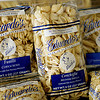
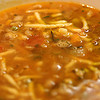

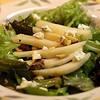
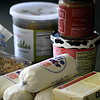
Last week’s Dark Days Challenge meals included:
Beef stroganoff
– Prather Ranch beef chuck, Far West Fungi white mushrooms and dried porcini, Eatwell onions, Clover Organic sour cream, homemade stock
– Eduardo’s Pasta Factory rotini and Dirty Girl haricots verts
Sunday lunch with friends
– Leek-Potato Soup: Little‘s potatoes, Eatwell leeks, homemade veggie broth
– Braised Lamb: Marin Sun Farms leg of lamb, Hedonia preserved lemons, Eatwell onions, Chateau Souverain sauvignon blanc, homegrown thyme, Happy Quail roasted peppers
– Bean & Rice Salad: Eatwell onions, Happy Quail sweet peppers, Rancho Gordo beans, Massa Organics brown rice
– Raita: Hamada cucumber, Chue’s cilantro, Redwood Hill goat yogurt
– Spice cake: Gina Marie cream cheese and Clover Organic butter, Alfieri almond brittle
– Wines: Chateau Souverain syrah, Merryvale Starmont sauvignon blanc
Soup & salad
– Pasta Fazool: Home-canned Mariquita tomatoes, Rancho Gordo heirloom beans, Fatted Calf pancetta, homemade chicken stock
– Pear salad: Little‘s lettuce, Apple Farm pears, Point Reyes blue cheese, Glashoff walnuts, Bariani olive oil, O vinegar
Stacked chile verde enchiladas
– Prather pork, Quail Hollow chiles and tomatillos, Eatwell onions, homemade stock, Rancho Gordo tortillas and beans, Spring Hill colby-jack cheese
Friday (…is always pasta night)
– Mastrelli ricotta raviolini topped with Hedonia marinara sauce
– Molinari hot Italian sausage, grilled
– Salad: Little’s lettuce, Glashoff walnuts, Three Sisters Serena cheese, Chue’s green onions, Bariani olive oil, O vinegar
– Rosenblum 2005 San Francisco Bay Zinfandel (from Alameda!? Who knew!)
cooking, entertaining, locavore, other blogs
8 Comments »




Posted by Anita on 11.04.07 10:16 PM
 Remember last month, all those Strega concoctions we resurrected for Raiders of the Lost Cocktail? Well, it seems yours truly has been anointed the winner of said challenge, and therefore the decider of this month’s challenge ingredient.
Remember last month, all those Strega concoctions we resurrected for Raiders of the Lost Cocktail? Well, it seems yours truly has been anointed the winner of said challenge, and therefore the decider of this month’s challenge ingredient.
Don’t be too impressed by my gold-medal status: I was the only entrant who actually followed the rules. So paltry was the attendance that I actually managed to take both first and second place. Of course, the scanty turnout might just could possibly sorta have been due to the relative obscurity of the target ingredient and the mysterious lack of published Strega recipes.
So in the spirit (hardy-har) of opening up the challenge to wider participation, let me propose a slightly more-mixable subject: Benedictine. It fits the bill quite neatly: A widely available product that has been known to gather dust, but one that well deserves a broader audience.
Like the now-trendy Chartreuse, Benedictine began its life behind abbey walls, the proprietary elixir of the monastic order that shares its name. A sweetened cognac base infused with 27 secret herbs and spices — the Colonel has nothing on those monks! — amber-hued Benedictine conjures up a set of heavenly flavors and aromas. It’s also the kind of spirit that makes curmudgeonly drinkers (and drink-makers) giddy. Here’s David Embury waxing poetic on the subject in The Fine Art of Mixing Drinks:
One of the oldest and best of all liqueurs, highly aromatic, and having a base of the finest cognac. It is made with consummate skill and is thoroughly aged. There are few liqueurs in the world that can compare with it.
Indeed, its balance and complexity has kept Benedictine from ever falling completely out of fashion. Although sales of herbal liqueurs rapidly declined after Prohibition, most every cocktail book in our library boasts at least one recipe for this concoction.
Certainly, it’s no stranger in this parish: We’ve mixed up no less than four recipes bearing the blessed tipple: Erik‘s guest-sermon on Bobby Burns, the Pegu Club’s Prince of Wales variation, a post-MxMo stab at the Cabaret, plus last Friday’s very own Widow’s Kiss.
One last word of warning, my children, before you venture forth in the world: Be not led astray. As the reverend Dr. Bamboo wisely cautions, the labeling of premixed “B&B” appears nearly identical to that of the pure liqueur. The wise man seeketh the right label.
Go now, and mix some more.





(Stay tuned to The Spirit World for the formal announcement and directions on how to enter, or check back here for a link in a day or so.)
drinks, other blogs, recipes
3 Comments »




Posted by Anita on 11.02.07 8:59 AM
 Dia de Los Muertos, or the Day of the Dead, is a bit of a misnomer, especially in Mexico where the festivities are often spread out over two or more days. Like most Latino holidays of a spiritual sort, this fiesta integrates indigenous traditions alongside Catholic feasts, blending traditional pre-Hispanic ancestor worship with the Europeans’ All Saints Day and All Souls Day. Children and other innocents are remembered on November 1, and those who died as adults are honored the next day and night. As someone for whom death is a relatively fresh memory, setting aside a few days to remember those we have lost seems eminently wise, a useful way of mourning together and acknowledging individual loss as part of a universal experience.
Dia de Los Muertos, or the Day of the Dead, is a bit of a misnomer, especially in Mexico where the festivities are often spread out over two or more days. Like most Latino holidays of a spiritual sort, this fiesta integrates indigenous traditions alongside Catholic feasts, blending traditional pre-Hispanic ancestor worship with the Europeans’ All Saints Day and All Souls Day. Children and other innocents are remembered on November 1, and those who died as adults are honored the next day and night. As someone for whom death is a relatively fresh memory, setting aside a few days to remember those we have lost seems eminently wise, a useful way of mourning together and acknowledging individual loss as part of a universal experience.
The celebration — somehow more intimate and yet more festive than Halloween — gives people time to openly remember their dearly departed, and many Mexican and Mexican-American families erect memorial altars in their homes. These ofrendas typically feature a photo of the deceased surrounded by candles, glasses of water, vases of marigolds, small statues of saints or skeletons, decorated sugar skulls, and plenty of food. In addition to the rich bread known as pan de muerto, altar offerings often include moles or other fragrant dishes, bottles of beer or tequila, and other treats to tempt the spirits of the departed to return for a visit home.
Not far from our house, the streets around 24th and Mission are filled with shoppers stocking their altars: The craft stores sell skeleton figurines and papel picado, the florists put out bunches and buckets of marigolds, the panaderias set up tables of pan de muertos on the sidewalk, and the smell of incense fills the air. The mood is festive and the decorations colorful, and tonight, there’ll be a festive parade through the heart of the Mission. What a civilized way to celebrate life’s ultimate certainty.





One of the most recognizable symbols of the fiesta is La Calavera de la Catrina, the fancy-lady skeleton. As with many macabre figures in Mexican folk art, La Catrina serves as a reminder that death comes for us all, even the well-to-do and the beautiful. But La Catrina doesn’t let her mortality stand in the way of a good time: She dons her best plumed hat and heads out for a jaunty stroll. Although La Catrina is, herself, dead, she looks so much like a storybook widow-in-black that it’s hard to remember that she’s actually the deceased, not the mourner. No wonder she feels so festive! If you catch her in the right moment, she might just give you a…
Widow’s Kiss
1-1/4 oz Calvados or other apple brandy
3/4 oz Benedictine
3/4 oz yellow Chartreuse
2 dashes aromatic bitters
Stir all ingredients with ice, then strain into a chilled cocktail glass. Garnish with a brandied cherry, or a sugar skull.
Drink of the Week, drinks, holidays & occasions, recipes, The Mission
4 Comments »




Posted by Anita on 11.01.07 8:12 AM
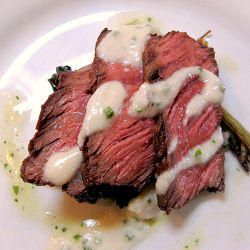 The Bay Area is blessed not only with an abundance of seasonal, local, sustainable food, but also with a cadre of chefs who have jumped on the locavore bandwagon with both feet. In fact, many of the places we eat on a regular basis have been actively supporting some of our favorite local farmers for even longer than we have.
The Bay Area is blessed not only with an abundance of seasonal, local, sustainable food, but also with a cadre of chefs who have jumped on the locavore bandwagon with both feet. In fact, many of the places we eat on a regular basis have been actively supporting some of our favorite local farmers for even longer than we have.
A few weeks ago, we were chatting with our server at Range, marveling at how they always have such spectacular beef. (And pork, and fish… but I digress.) “Oh, yeah,” he countered, “They get it from a local outfit called Prather Ranch.”
Our Prather Boys? Well, that sure explains a lot. I mean, we knew Chef West bought much of his raw materials from local sources; our friend Steve sells him sacks of heirloom beans and hominy, after all. But, man, when we found out their little bovine secret, we felt like the chef and his entire staff had been holding out on us.
I kid. Mostly. But we did try to impress upon the waiter that this was information we could have used. Not that we could eat at Range any more than we already do and still manage to pay the mortgage, but now we can count our dinners there as locavore meals, too? Heck yeah, sign us up.
Our server explained that the chef wants to avoid the plague of a supplier-studded menu, preferring to let his food speak for itself without a litany of ‘So-and-So Farms’ and ‘Those Guys Ranch’ cluttering up the joint. Grudgingly, I concede the point — all that namedropping can be distracting.
But elsewhere, we’re starting to see evidence of a happy medium.
Many newer entrants to the San Francisco restaurant scene fly their locavore flag high. Last week, we had the coincidental pleasure of dining at two of them: Nopa — a widely hailed anchor of its eponymous neighborhood’s revival — and Fish & Farm, a newly minted upscale experiment on the dodgy fringes of the Tenderloin. Both dinners were delicious, interesting, and varied; both menus made clear statements of their chef’s intention to support local farms, and listed their suppliers by name… not in the description of each dish, but in a separate section. The two restaurants couldn’t have been less similar in most other ways: Decor, plating, service, vibe, pacing, wine program, and clientele; no cookie-cutter knockoffs here. Praise the Lord and pass the (locally pastured) pork chops.
 Most locavores would be thrilled to have even two hot, newish restaurants to add to their repertoire. But it’s better that that, by a mile. Nopa and Fish & Farm are just two members of a sizable and ever-growing subgenre of Northern California dining. Witness this extensive list of Bay Area chefs and restaurants committed to sourcing at least some of their ingredients locally (Tana from I [heart] Farms kicked it off two years ago, when “locavore” and “foodshed” were about as widely understood as quantum physics). Clamoring for more options? Pick up or download a copy of the newly published ‘Buy Fresh, Buy Local‘ guide, highlighting area restaurants alongside farms, purveyors, and other member businesses.
Most locavores would be thrilled to have even two hot, newish restaurants to add to their repertoire. But it’s better that that, by a mile. Nopa and Fish & Farm are just two members of a sizable and ever-growing subgenre of Northern California dining. Witness this extensive list of Bay Area chefs and restaurants committed to sourcing at least some of their ingredients locally (Tana from I [heart] Farms kicked it off two years ago, when “locavore” and “foodshed” were about as widely understood as quantum physics). Clamoring for more options? Pick up or download a copy of the newly published ‘Buy Fresh, Buy Local‘ guide, highlighting area restaurants alongside farms, purveyors, and other member businesses.
And the list is growing all the time. Over at In Praise of Sardines, our friend Brett is documenting the process of designing, building, and otherwise launching his as-yet-unnamed Noe Valley restaurant. He describes his project as “seasonal, sustainable California fare with a Spanish flair”. A cool concept, to be sure, but he could use your help with choosing a name. Some of the ideas he’s tossing around have legs, but perhaps you’ve got a better one. Did I mention there’s a list of prizes? And some great writing? Why are you still here? GO, make your mark on our locavore restaurant scene!


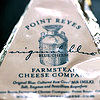
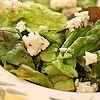

What, you’re still here? Ok, ok… here’s our Dark Days Challenge wrapup. Despite last week’s unintended focus on dining out, we did still manage to make a number of locavore meals at home:
Pan chicken with mushroom sauce
– Marin Sun Farms chicken, homemade stock, Far West Fungi mushrooms
– orecchiete (non-local; exempt)
– Ella Bella Farm broccoli di ciccio
Steak and potatoes
– grilled Prather Ranch spencer steak
– mashed potatoes (Little’s)
– red-leaf lettuce (Little’s) with Point Reyes Bleu, Bariani olive oil, O cabernet vinegar
Friday night pasta
– a repeat of the salad above
– meat sauce made with Prather beef and pork, Mariquita tomatoes, Eatwell onions
– garlic bread: Clover Organic butter, Acme pain de mie heels, local garlic, local parsley
– linguine (non-local; exempt)
locavore, restaurants
7 Comments »




Posted by Anita on 10.31.07 7:05 AM
 Once upon a time, there was a spoiled teenager named Anita who refused to eat ribs, chicken legs, or any other meat shaped like a body part.
Once upon a time, there was a spoiled teenager named Anita who refused to eat ribs, chicken legs, or any other meat shaped like a body part.
One year, the child’s mother took ill on Thanksgiving morning, with a gaggle of relatives due to descend upon the family home in mere hours. The mere thought of sticking her hand inside (inside!) the body of a turkey made the girl turn green around the edges, but there was nothing to it but to do it: In went the hand, out came the slimey giblet bag. In a word: Gack!
Years later, the girl grew up and got over herself. A culinary school butchery class, which involved parting out cases of chickens and breaking down sides of beef, rid her of the last vestiges of meat squeamishness. The woman became secure with her place on the food chain, an unrepentant carnivore at last.
Flash forward to 2007: In a crisis over the disappearance of Hoffman Farms chickens from the local farmers market, we started buying our weekly roaster from Marin Sun Farms. We’d blithely strolled past their stand for months, seeing the signs for chickens, never venturing in to price them; our Hoffman loyalties were that strong. But the disappearance of their main competition emboldened these farmers, and they began putting their wares on more prominent display: First in bins by the edge of their stall, then moving to a large, copiously iced display — complete with protruding chicken feet — right out in the pathway. (Just the other day, I saw a group of tourists laughing nervously and taking pictures; it’s quite the sight if you’re not used to such things.)
The first afternoon of our patronage, we brought our fine-footed fowl home. The idea of cutting off chicken feet didn’t faze me a bit, I smugly noted. It wouldn’t be any worse than snipping off wingtips, really. I’d seen enough dim sum to grasp the comic possibilities of disembodied chicken feet, and I knew their gelatinous cartilage would add body to our next batch of stock.
I plopped the bagged bird in the sink and turned on the water. Cutting through the rubber band that held the bag shut, I accidentally grazed my arm on a stray claw. (Note to self: Chickens — at least the ones that aren’t factory-gorged on corn — scratch for their supper.) But the sting of avian revenge was no match for the shock I got when I pulled Henny Penny out of the bag: Her frickin’ head was still attached!
Or, well, mostly attached. The neck had been slashed (quite tidily) and her noggin wobbled around on the impossibly long neck in a rather ghastly fashion. Her tiny eyes were mercifully shut, but you could quite clearly make out what her features must have looked like, mere days ago. A tiny comb was clearly visible at the crown of her egg-sized skull. Oh, my…
Snapping out of my guilt-laden reverie, I laughed aloud, amused at how a small, dead hen could rattle me so. Would I have bought her, had I know she came fully equipped? Probably. But coming upon an unexpected beaky face in the bottom of the bag was more than I was expecting. I wondered whether the farmers enjoyed imagining the shock they inflicted on unsuspecting city slickers, but most likely they never gave it a moment’s thought. It’s a chicken, to them. Their livelihood, our supper.
It gets easier, week by week, staring my dinner in the face on a Sunday afternoon. I’ve even come to see the gallows humor in the macabre ritual of removing heads, necks, and feet. I’m not sure I could ever kill a chicken, maybe not even gut a dead one (I’m still not all that happy about innards, truth be told). But if I’m going to be an ethical carnivore, I figure that looking my meat in the eye is the least I can do. And so I do, with silent thanks to the farmer and the chicken.
And then I cackle like a fiend as I throw the dismembered bits in the stockpot. Muuu-huuu-huuu-ahhh!





Chicken Stock, Simplified
4 to 5 pounds raw or frozen chicken bits (wings, backs, necks, and feet)
6 quarts filtered water
1 pound mirepoix, very large dice (1 inch or so)
– 1 large onion
– 2 medium carrots
– 2 large celery stalks, trimmed
Bouquet garni
– 2 cloves garlic
– 8 peppercorns
– 3 whole cloves
– 2 fresh thyme sprigs
– 6 parsley stems
…tied with twine in a cheesecloth bundle
In your largest pot, bring water and chicken parts to a simmer; reduce to a lazy bubble and cook for 3 hours. Add the mirepoix and bouquet garni and cook for an additional hour. Strain through cheesecloth or a very fine mesh sieve into a large bowl (or a cool stockpot). Cool to room temperature using an ice-water bath or immersible stock chiller, then chill completely overnight.
The next day, skim the fat and measure stock in 2-cup portions into quart-size freezer bags. Holding the bag upright, squeeze to remove excess air, then seal. Freeze bags flat on a rimmed cookie sheet until completely solid; they can then be stored in your freezer’s pull-out bins, filed like flip-cards along with pasta sauce and other flat-packed liquids. Any odd measures of stock can be frozen in ice-cube trays for quick use in pan sauces and other recipes requiring small amounts of liquid. Store frozen stock for up to 6 months.
cooking, farmers markets, locavore, meat, recipes
16 Comments »




Posted by Anita on 10.28.07 7:50 PM
 When my mom was growing up, homemade dessert was a regular occurrence around the dinner table. By the time I was a kid, the family tradition had lapsed; cakes and pies showed up mostly around the holidays or on someone’s birthday. Not that I felt deprived: To this day, my idea of dessert is scraping the bowl for the last spoonful of mashed potatoes, or sneaking an extra meatball from the lunch-bound leftovers.
When my mom was growing up, homemade dessert was a regular occurrence around the dinner table. By the time I was a kid, the family tradition had lapsed; cakes and pies showed up mostly around the holidays or on someone’s birthday. Not that I felt deprived: To this day, my idea of dessert is scraping the bowl for the last spoonful of mashed potatoes, or sneaking an extra meatball from the lunch-bound leftovers.
Despite my defective sweet tooth, I love to bake for friends and family. At my office in Seattle, I belonged to a crew of hard-core amateur pâtissières dubbed the Spare Change Bakery. We all kept jars on our desks for our coworkers’ contributions, and as soon as we scraped together enough nickels and dimes, one of us would whip up a double- or triple-batch of something sweet and scrumptious for the next staff meeting. By the time we disbanded, we were collecting enough cash to bake every week — a gratifying but rather exhausting sign of our popularity.
But since we moved back to San Francisco, I haven’t had many excuses to bake. Sure, our dinner parties often need a sweet ending, but I miss those crowd-pleasing desserts: Brownies, bars, and other decidedly lowbrow sweets. So when I saw the photo of the Spice Cake with Coffee Toffee Crunch on the cover of the new issue of Sunset, I knew my path was clear. The theme for this month’s “Waiter, There’s Something in My…” event is layer cakes, after all, and there’s just something about a sky-high cake with cream-cheese frosting that sends me running for my sifter and whisk.
 Working my way through the recipe, I found it refreshingly well documented. The writer details a number of steps — creating a crumb coat, and using strips of parchment to keep the serving plate clean — that help give the final cake a centerpiece-worthy appearance. With the exception of the recipe’s lack of measurements by weight (the serious baker’s preferred method for dry ingredients like flour and sugar, especially), it was one of the best-written magazine recipes I’ve used in months.
Working my way through the recipe, I found it refreshingly well documented. The writer details a number of steps — creating a crumb coat, and using strips of parchment to keep the serving plate clean — that help give the final cake a centerpiece-worthy appearance. With the exception of the recipe’s lack of measurements by weight (the serious baker’s preferred method for dry ingredients like flour and sugar, especially), it was one of the best-written magazine recipes I’ve used in months.
Aside from substituting Alfieri Farms’ almond brittle for homemade coffee toffee, I followed the recipe to the letter, so click over to Sunset’s site if you want the full rundown. Although I doubt the magazine’s suggestion that this cake will replace pumpkin or pecan pie on your holiday dessert buffet, it’s got a spicy, deep flavor that would make a perfect finish for an autumn feast. While the icing’s got enough sugar to satisfy even the most intense sugar junkie, the cake itself — sweetened with molasses — keeps things moist and spicy without too much sweetness… just the ticket for a baker without a sweet tooth.





baking, dessert, magazines, other blogs
10 Comments »




Posted by Anita on 10.26.07 7:04 AM
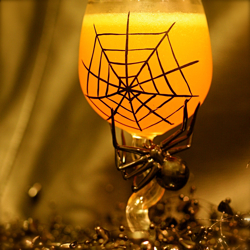 Despite its spooky name and eerie orange glow, Satan’s Whiskers is not the least bit diabolical. Unlike many vintage cocktails that shape-shifted their way across the decades, this drink’s somehow kept its original form throughout time.
Despite its spooky name and eerie orange glow, Satan’s Whiskers is not the least bit diabolical. Unlike many vintage cocktails that shape-shifted their way across the decades, this drink’s somehow kept its original form throughout time.
Both the Savoy Cocktail Book and Patrick Gavin Duffy’s Official Mixer’s Manual call for equal parts gin, sweet vermouth, dry vermouth, and orange juice, plus half as much Grand Marnier as gin, and a dose of orange bitters. Some sources call for equal parts of all the ingredients and a dash of bitters; others hew to a half-measure of liqueur and also decrease the juice.
Truth be told, there’s more variation to be had from using different brands of vermouths (especially the sweet varieties) than any of these minor tweaks will afford; we like the flavor of Cinzano Rosso best, both on its own and mixed in the Whiskers. We used Sarticious gin — yet another local liquor, distilled over the hill in Santa Cruz — but any straightforward dry gin will do the trick.
Being great lovers of compromise, our recipe below is mostly Savoy, with a little extra bitters. If your liquor cabinet lacks Grand Marnier, you can substitute orange curacao for a variation known as “curled”. And if autumn’s chill gives you a craving for dark spirits, you might follow the lead of our friends at the Zig Zag Cafe, who make a delicious alternative dubbed Satan’s Soulpatch, replacing the gin with bourbon.





Satan’s Whiskers (Straight)
3/4 oz dry gin
3/4 oz sweet vermouth
3/4 oz dry vermouth
3/4 oz fresh-squeezed orange juice
1/2 oz Grand Marnier
2-3 dashes orange bitters
Shake all ingredients with ice; strain into a chilled cocktail glass.
For Satan’s Whiskers (Curled): Substitute orange curaçao for the Grand Marnier
For Satan’s Soulpatch: Substitute bourbon for the gin

1 year ago: Corpse Reviver #2
Drink of the Week, drinks, recipes
5 Comments »




Posted by Anita on 10.23.07 1:37 PM
 When I think about the bloggers participating in the Dark Days Challenge in places like Maine or Minnesota or Michigan — places where winter actually involves snow, frost, and farmers markets that close for the season — I feel like a fraud.
When I think about the bloggers participating in the Dark Days Challenge in places like Maine or Minnesota or Michigan — places where winter actually involves snow, frost, and farmers markets that close for the season — I feel like a fraud.
We still had tomatoes at our market this weekend — heirlooms and Early Girls and a rainbow of Sweet 100s — from a surprising number of farms. They sat there in their little cliques, cozying up to their buddies, red peppers and basil. You could almost imagine them standing in front of a mirror inspecting their own summery plumpness and silently mocking the homespun pumpkins and Brussels sprouts on the next table over.
Frankly, I’m over these cheeky girls of summer. I’m ready for the potatoes and the greens and the crisp new apples. It’s a little eerie to realize that I could eat today the same meals we made in June without even leaving the market. I even saw three different vendors who were still selling strawberries… they’ve been on the farm tables since the first week of April, for goodness sake. I’ll be sad when the pasture-raised chickens come to an end, but that’s really all I’m going to miss from summer. Autumn is my favorite eating season.
 We started out our Dark Days Challenge last week with some of our favorite standbys. We make these dishes a lot, and we’re pretty dialed in on where to find their ingredients from local sources. And I suppose that’s one of the benefits of eating locally all the time: With the exception of farmers dropping out of your market, you pretty much know where to find your favorite things, after a while. You also know, eventually, what’s hard (or even impossible) to find; it makes you more alert when you spy something you haven’t found locally before.
We started out our Dark Days Challenge last week with some of our favorite standbys. We make these dishes a lot, and we’re pretty dialed in on where to find their ingredients from local sources. And I suppose that’s one of the benefits of eating locally all the time: With the exception of farmers dropping out of your market, you pretty much know where to find your favorite things, after a while. You also know, eventually, what’s hard (or even impossible) to find; it makes you more alert when you spy something you haven’t found locally before.
Speaking of which, our friend Cookie turned me on to a local source for wheat flour and polenta. Although Full Belly Farms is about 100 miles away, they don’t come to my local market — they sell at weekday markets in places I can’t get to during the workday, plus one Saturday market down in Palo Alto, 30+ miles south of us. So now I get to make the choice about whether it’s better to drive an hour to buy the local option, or stick with my carb exemption. The other good news is that I found out (from Cookie, again) that the white rice we’ve been buying is harvested semi-locally… about 150 miles away.
Here’s what last week looked like:
Chicken & Dumplings
– Marin Sun Farms chicken; onions, carrot, celery from the market; garden herbs
– biscuit mix from Beth’s in San Rafael; Clover Organic milk
Chili Dogs (can’t watch the playoffs without ‘dogs!)
– Prather Ranch uncured hotdogs and Acme pain de mie buns
– Chili made with our own tomato sauce and homemade pork sausage, plus Prather chuck
– Eatwell Farms onions, and non-local (but organic) cheese
Oxtail Ragu and Pasta
– Marin Sun Farms oxtails braised with our own chicken stock and tomato sauce
– salad: red-leaf lettuce (Little), avocado (Will’s) and tomatoes (Everything Under the Sun)
– non-local dried orecchiete pasta
Pork & Potatoes
– Double-cut Prather Ranch pork loin chop on the grill
– Roasted Iacopi Farm brussels sprouts with Bariani olive oil
– Roasted ‘rose Finn apple’ potatoes from Mr. Little
Pasta (Not-Quite-)Bolognese
– meat sauce made with Prather beef and pork, Mariquita tomatoes, Eatwell onions
– garlic bread: Clover Organic butter, Acme rolls, local garlic
– non-local dried pasta
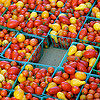


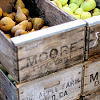
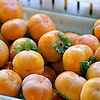
farmers markets, locavore, other blogs
10 Comments »




Posted by Anita on 10.19.07 7:02 AM
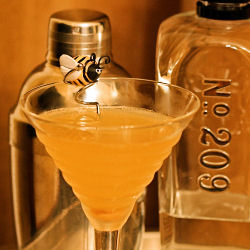 Last weekend, Cameron and I spent the better part of our monthly cocktail budget on a pair of tickets to the Independent Spirits Fest. Although my mom thought it sounded like the kind of groovy gig where you’d follow your bliss, it’s actually a trade show for distillers who aren’t aligned with any of the booze juggernauts.
Last weekend, Cameron and I spent the better part of our monthly cocktail budget on a pair of tickets to the Independent Spirits Fest. Although my mom thought it sounded like the kind of groovy gig where you’d follow your bliss, it’s actually a trade show for distillers who aren’t aligned with any of the booze juggernauts.
One of the best Fest perks was the opportunity to taste a number of liquors you can’t easily put your hands on, either because they’re too rare (often combined with “too pricey”), or too new to find in stores. With more than 30 exhibitors filling two small conference halls, we decided to focus on those near to our heart: Folks making booze in Northern California.
Between us, we tasted 20+ locally-produced items from a dozen different producers over the course of the evening. (Don’t worry: Most ended up in the spit bucket, and we took a cab home.) Some names you’d recognize from the shelf of your local bar, like Junipero gin and Hangar One vodka. But many new-to-us discoveries — like St. George’s lovely single malt, a bierschanaps made in Mountain View, and Charbay’s haunting pastis — were almost worth the cost of admission.
Best of all, it was a treat to find so many liquors produced within 100 miles of our home bar. Of the major booze families, I think we’re really only lacking a local American-style whiskey (one’s coming soon from Pioneer Spirits in Chico, with any luck) and a tequila equivalent, which can only be a matter of time given the mezcal explosion and the Bay Area’s love affair with agave.
But even after Wednesday’s Dark Days post, I can’t say that we’re going totally loca-boire. I think it’s safe to say, however, given the diversity of what we found — gin, whisky, rum, vodka, brandies, eaux de vie, liqueurs of all sorts — you’ll start seeing a lot more local products on our shelf, and on the blog.
—-
But on to this week’s drink: I’d been playing with honey drinks for a while, but it wasn’t until I sat down with my brand-new (to me) copy of David Embury’s classic The Fine Art of Mixing Drinks that I found one that really appealed to my tastes. Early in the book, Embury holds forth on the dark days of Prohibition and the birth of a number of “pernicious” cocktails, including a concoction christened the Bee’s Knees — equal parts honey, lemon, and gin. Thankfully, the days of bathtub gin are long behind us, and the modern version of the drink (which Embury endorses in later chapters) calls for saner proportions.
The glorious thing about the Bee’s Knees — which fully lives up to its name — is that it’s another one of those drinks you can easily make with ingredients you keep around the house. And, if you’re lucky like us, even with ingredients grown or distilled within a few miles of home. Careful observers will note it’s a close relative of the Whiskey Sour, and it shares that drink’s easygoing ways.
Although they weren’t exhibiting at the Fest, our favorite white liquor these days is sassy 209 Gin, distilled along the San Francisco waterfront at Pier 50 (a full 6 miles from our door, if you’re counting). It’s a lovely, mixable spirit, well-balanced but spunky.
The honey we get from Meeks’ in Soquel (72 miles) is fairly solid stuff. To bring it to a spreadable consistency, we usually warm the jar in a small saucepan of water. Alas, that’s not such a clever idea when mixing drinks: Hot honey isn’t exactly conducive to a crisp and cool cocktail, and it seizes back up as soon as it hits the ice. The problem’s easily remedied by using honey syrup: Heat equal parts honey and water in a pan, stir until dissolved, then pour into a bottle for storage (in the fridge, please).
Last but not least, there’s lemon juice. Although local honeybees are big fans of our backyard Meyer lemon tree, its current crop of fruit isn’t quite ripe. Luckily, a number of the farmers at the Ferry Building market keep us well supplied with Eureka lemons. In a few weeks, when our lemons turn yellow at last, this drink’ll get about as local as can bee.


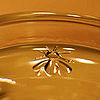


Bee’s Knees
2 oz dry gin
1 oz lemon juice
1 oz honey syrup
Shake all ingredients with ice, and strain into a chilled cocktail glass.
———-
Drink of the Week, 1 Year Ago: Moscow Mule
Drink of the Week, drinks, locavore, recipes
17 Comments »




Posted by Anita on 10.17.07 7:35 AM
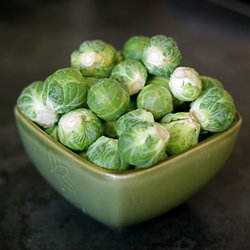 So many variables factor into the bounty of the Bay Area’s foodshed: The density and affluence of our population creates a bumper crop of food-obsessed consumers, our progressive social milieu fosters an interest in sustainability, and the richness of our restaurant scene rewards ambitious farmers.
So many variables factor into the bounty of the Bay Area’s foodshed: The density and affluence of our population creates a bumper crop of food-obsessed consumers, our progressive social milieu fosters an interest in sustainability, and the richness of our restaurant scene rewards ambitious farmers.
But underneath all that is the inescapable fact that we live in one of the most fertile food-growing regions in the country. Add to that an eye-crossing number of microclimates, and the result is an astounding variety of warm-weather crops from just-spring to deep autumn. Even in winter, our markets offer an almost unbelievable abundance.
I know that most other regions don’t have it so easy; reading the seasonal posts of other food bloggers brings that fact home. Eating locally, especially year-round, can be a struggle for even the most dedicated fanatic. In most areas, the first frost pretty much spells doom for the locavore agenda, save for home-preserved harvests, hardy winter crops, and often-pricey meats and cheeses.
So when I read on the Eat Local Challenge blog that an autumn-into-winter locavore event was afoot, I had to check it out. Laura — who writes a charming blog called Urban Hennery out of Everett, Washington — is blogging her latest experiment: Feeding herself, her husband, and her friends on local foods throughout the remainder of the year. She’s challenged anyone interested to join her, christening the event the Dark Days Challenge.
I signed on with Laura without giving the idea much thought… without realizing that this snap decision means we’re going to become a lot more candid about the choices we’re making when we shop. This isn’t just a one-week flirtation with locavore exhibitionism, as we’ve done before. But I know we can do it because it’s what we’ve been doing pretty much all summer long, on the sly. And, honestly? Not doing it here — in what must be the easiest place in the country to attempt this challenge — would feel churlish.
My name’s Anita, and I’m …a locavore. There, I said it.
All joking aside, I’ve been bashful of talking about what we’re doing, mostly because I am leery of sounding sanctimonious or self-congratulatory. Food choices are incredibly personal, and if you have strong opinions about what you eat and why, it can be hard to talk about them without seeming snobbish. Or condescending. Or egotistical. Or just vain.
So, in order to salve my fears, I’ll say this and then trust that you’ll give us the benefit of the doubt: Eating sustainable, local, and organic food whenever possible is important to us. But by sharing what we’re doing, we are in no way condemning anyone else’s choice.
Enough of that, and full speed ahead. We’re on this bandwagon for the full ride. Expect to hear about our locavore adventures — the triumphs and the challenges, as Laura says — throughout the fall. We’ll continue to eat as locally as we can as often as we can, and write about it at least once a week until New Year’s Day.
 Laura has encouraged her Dark Days cohorts to modify the house rules to suit their circumstances. Based on our experience in past challenges, we’ve held ourselves to a harder line with some items (like produce miles) and taken a more realistic approach to others (like carbs). Here’s our general game-plan:
Laura has encouraged her Dark Days cohorts to modify the house rules to suit their circumstances. Based on our experience in past challenges, we’ve held ourselves to a harder line with some items (like produce miles) and taken a more realistic approach to others (like carbs). Here’s our general game-plan:
- We will continue to cook locally as often as we can, with a baseline of two dinners per week made from 90% local ingredients.
- We will write about at least two meals a week made with as many local ingredients as we can source.
- Local for us will be a 100-mile radius for produce and a 200-mile radius for protein. Strong preference will be given to items purchased direct at the farmers market rather than retail.
- We’re making the usual ‘Marco Polo’ exemptions for seasonings. We’re also making exceptions for flour, dried pasta, white rice, and polenta — we have no local sources of these ingredients, and man does not live by potatoes and bread alone. We will try to source baking ingredients locally, but I don’t expect to find much beyond nuts, and I won’t go through the holidays without baking.
- We’ll try to limit processed foods to those produced within a 50-mile radius. We’ll try to determine how much local ingredient sourcing they’re doing, and talk about it in our posts.
- We’ll continue with the challenge through the end of the year, and then re-evaluate on New Year’s Day along with other participants.



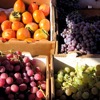
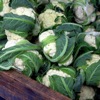
locavore, other blogs
8 Comments »




 I don’t know about you, but it seems lately like my life is exploding with insanity. It’s not just work, either; it’s home and dogs and life in general. It’s all rush-rush, crazy nonstop chaos… and it’s not even the holidays yet.
I don’t know about you, but it seems lately like my life is exploding with insanity. It’s not just work, either; it’s home and dogs and life in general. It’s all rush-rush, crazy nonstop chaos… and it’s not even the holidays yet. New to our pantry this week, sorted by distance:
New to our pantry this week, sorted by distance:














 Dia de Los Muertos, or the
Dia de Los Muertos, or the 
















































